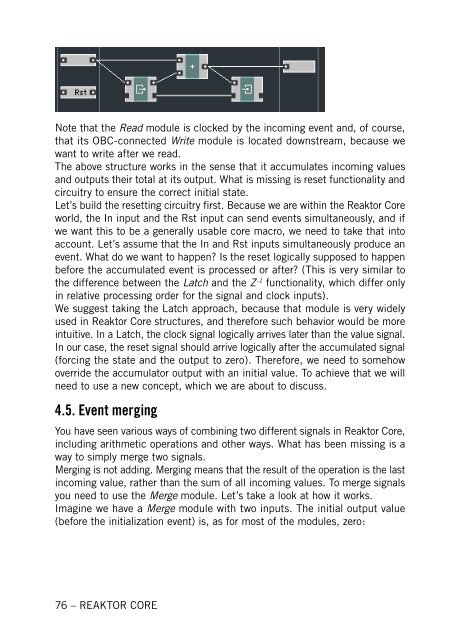1. First steps in Reaktor Core - Native Instruments
1. First steps in Reaktor Core - Native Instruments
1. First steps in Reaktor Core - Native Instruments
You also want an ePaper? Increase the reach of your titles
YUMPU automatically turns print PDFs into web optimized ePapers that Google loves.
Note that the Read module is clocked by the <strong>in</strong>com<strong>in</strong>g event and, of course,<br />
that its OBC-connected Write module is located downstream, because we<br />
want to write after we read.<br />
The above structure works <strong>in</strong> the sense that it accumulates <strong>in</strong>com<strong>in</strong>g values<br />
and outputs their total at its output. What is miss<strong>in</strong>g is reset functionality and<br />
circuitry to ensure the correct <strong>in</strong>itial state.<br />
Let’s build the resett<strong>in</strong>g circuitry first. Because we are with<strong>in</strong> the <strong>Reaktor</strong> <strong>Core</strong><br />
world, the In <strong>in</strong>put and the Rst <strong>in</strong>put can send events simultaneously, and if<br />
we want this to be a generally usable core macro, we need to take that <strong>in</strong>to<br />
account. Let’s assume that the In and Rst <strong>in</strong>puts simultaneously produce an<br />
event. What do we want to happen? Is the reset logically supposed to happen<br />
before the accumulated event is processed or after? (This is very similar to<br />
the difference between the Latch and the Z -1 functionality, which differ only<br />
<strong>in</strong> relative process<strong>in</strong>g order for the signal and clock <strong>in</strong>puts).<br />
We suggest tak<strong>in</strong>g the Latch approach, because that module is very widely<br />
used <strong>in</strong> <strong>Reaktor</strong> <strong>Core</strong> structures, and therefore such behavior would be more<br />
<strong>in</strong>tuitive. In a Latch, the clock signal logically arrives later than the value signal.<br />
In our case, the reset signal should arrive logically after the accumulated signal<br />
(forc<strong>in</strong>g the state and the output to zero). Therefore, we need to somehow<br />
override the accumulator output with an <strong>in</strong>itial value. To achieve that we will<br />
need to use a new concept, which we are about to discuss.<br />
4.5. Event merg<strong>in</strong>g<br />
You have seen various ways of comb<strong>in</strong><strong>in</strong>g two different signals <strong>in</strong> <strong>Reaktor</strong> <strong>Core</strong>,<br />
<strong>in</strong>clud<strong>in</strong>g arithmetic operations and other ways. What has been miss<strong>in</strong>g is a<br />
way to simply merge two signals.<br />
Merg<strong>in</strong>g is not add<strong>in</strong>g. Merg<strong>in</strong>g means that the result of the operation is the last<br />
<strong>in</strong>com<strong>in</strong>g value, rather than the sum of all <strong>in</strong>com<strong>in</strong>g values. To merge signals<br />
you need to use the Merge module. Let’s take a look at how it works.<br />
Imag<strong>in</strong>e we have a Merge module with two <strong>in</strong>puts. The <strong>in</strong>itial output value<br />
(before the <strong>in</strong>itialization event) is, as for most of the modules, zero:<br />
76 – REAKTOR CORE










